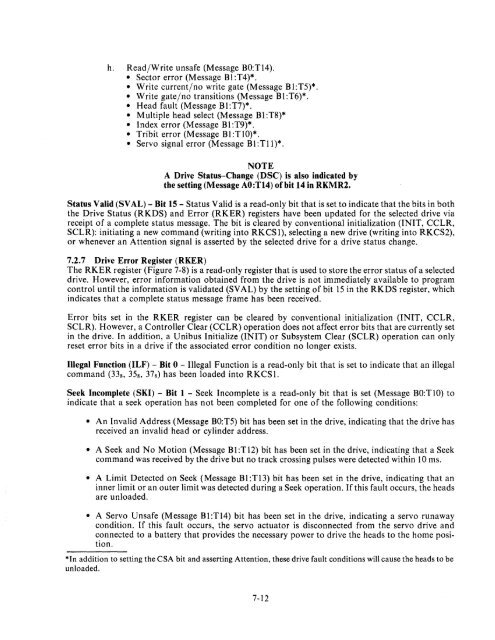RK06/RK07 Disk Drive User's Manual - Trailing-Edge
RK06/RK07 Disk Drive User's Manual - Trailing-Edge
RK06/RK07 Disk Drive User's Manual - Trailing-Edge
You also want an ePaper? Increase the reach of your titles
YUMPU automatically turns print PDFs into web optimized ePapers that Google loves.
h. Read/Write unsafe (Message BO:TI4).<br />
• Sector error (Message Bl :T4)*.<br />
• Write current/no write gate (Message Bl:T5)*.<br />
• Write gate/no transitions (Message Bl :T6)*.<br />
• Head fault (Message Bl:T7)*.<br />
• Multiple head select (Message Bl :T8)*<br />
• Index error (Message Bl :T9)*.<br />
• Tribit error (Message Bl:TI0)*.<br />
• Servo signal error (M essage B 1: T 11)* .<br />
NOTE<br />
A <strong>Drive</strong> Status-Change (DSC) is also indicated by<br />
the setting (Message AO:TI4) of bit 14 in RKMR2.<br />
Status Valid (SV AL) - Bit 15 - Status Valid is a read-only bit that is set to indicate that the bits in both<br />
the <strong>Drive</strong> Status (RKDS) and Error (RKER) registers have been updated for the selected drive via<br />
receipt of a complete status message. The bit is cleared by conventional initialization (INIT, CCLR,<br />
SCLR): initiating a new command (writing into RKCS 1), selecting a new drive (writing into RKCS2),<br />
or whenever an Attention signal is asserted by the selected drive for a drive status change.<br />
7.2.7 <strong>Drive</strong> Error Register (RKER)<br />
The RKER register (Figure 7-8) is a read-only register that is used to store the error status of a selected<br />
drive. However, error information obtained from the drive is not immediately available to program<br />
control until the information is validated (SVAL) by the setting of bit 15 in the RKDS register, which<br />
indicates that a complete status message frame has been received.<br />
Error bits set in the RKER register can be cleared by conventional initialization (lNIT, CCLR,<br />
SCLR). However, a Controller Clear (CCLR) operation does not affect error bits that are currently set<br />
in the drive. In addition, a Unibus Initialize (INIT) or Subsystem Clear (SCLR) operation can only<br />
reset error bits in a drive if the associated error condition no longer exists.<br />
Illegal Function (ILF) - Bit 0 - Illegal Function is a read-only bit that is set to indicate that an illegal<br />
command (33 8, 35 8 , 37 8) has been loaded into RKCS 1.<br />
Seek Incomplete (SKI) - Bit 1 - Seek Incomplete is a read-only bit that is set (Message BO:TI0) to<br />
indicate that a seek operation has not been completed for one of the following conditions:<br />
• An Invalid Address (Message BO:T5) bit has been set in the drive, indicating that the drive has<br />
received an invalid head or cylinder address.<br />
• A Seek and No Motion (Message B l:T 12) bit has been set in the drive, indicating that a Seek<br />
command was received by the drive but no track crossing pulses were detected within 10 ms.<br />
• A Limit Detected on Seek (Message Bl :TI3) bit has been set in the drive, indicating that an<br />
inner limit or an outer limit was detected during a Seek operation. If this fault occurs, the heads<br />
are unloaded.<br />
• A Servo Unsafe (Message Bl:T14) bit has been set in the drive, indicating a servo runaway<br />
condition. If this fault occurs, the servo actuator is disconnected from the servo drive and<br />
connected to a battery that provides the necessary power to drive the heads to the home position.<br />
*In addition to setting the CSA bit and asserting Attention, these drive fault conditions will cause the heads to be<br />
unloaded.<br />
7-12
















